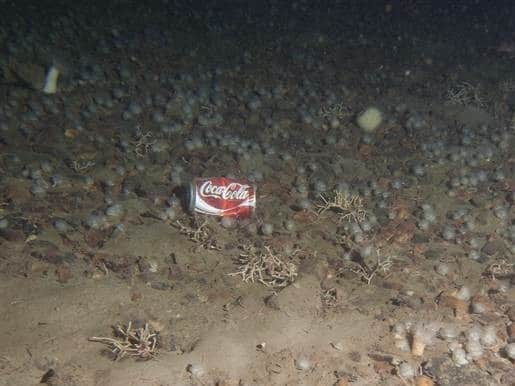Trash is piling up on the Arctic seabed

 German researchers analyzing the state of Arctic waters have determined that more trash is littering the Arctic seabed than ever before, reaching garbage density levels similar to seabeds next to densely populated regions further to the south.
German researchers analyzing the state of Arctic waters have determined that more trash is littering the Arctic seabed than ever before, reaching garbage density levels similar to seabeds next to densely populated regions further to the south.
Trash, much of it in the form of plastic litter, is becoming a serious problem for the ocean’s ecosystems. A paltry five per cent of plastic items are recycled effectively, leaving much of the rest to either languish for centuries in landfills or end up in the world’s oceans, where it can deteriorate into harmful microplastics. Experts say that exponential increases in plastic production, along with overfishing, will mean that by the year 2050 there will be more plastic than fish in the Earth’s waters.
Though remote and relatively free of human interaction, Arctic seas are not immune to the problem, where a new study finds that garbage littering the Arctic seabed has seen a 20-fold increase in just the past ten years.
Researchers from the Alfred Wegener Institute in Bremerhaven, Germany, analyzed a total of 5018 photographs taken by an underwater camera at a depth of 2500 metres near a group of HAUSGARTEN research stations in the Fram Strait between Greenland and Svalbard. The result was a calculated 3,485 pieces of litter per square kilometre. Glass, rope, metal and cardboard were some of the main types of litter, but almost half (47 per cent) of all items were identified as plastics, an amount which indicates a growing plastic problem for the Arctic, says the researchers.
“Our findings indicate that the Arctic faces a pollution problem and that it is spreading to the north,” say the new study’s authors. “Litter densities at HAUSGARTEN were substantially higher compared with other locations, despite its remote location.”
The findings are surprising, as litter densities in the Greenland Sea were found to be similar to those reported from the Lisbon Canyon off the coast of the densely populated Portuguese capital. The researchers put the blame squarely on the increase in ship traffic, finding positive correlations between litter densities and total ship counts in particular areas.
More than just an eyesore, the Arctic litter affects life on the seafloor, with the majority of identified litter items found to be interacting with (and entangling) the ocean life forms.
The researchers say their results add to the growing evidence that plastic production and the post-consumer handling of plastics needs addressing. “Whatever the causes, the present study highlights once more that our current waste management frameworks are inadequate to tackle the problem of marine litter pollution and that we have to re-think our usage of plastic materials,” say the study’s authors.
The sentiment echoes that of World Wildlife Fund Canada’s CEO David Miller who has stated that plastics and their toxic chemicals are unfortunately a bigger problem in the Arctic than previously assumed.
“In the Arctic, because the ice traps them, the abundance of microplastics are at least three times more than in other areas in oceans, including the Great Pacific Garbage Patch, which is THE concentration of plastics,” says Miller to the CBC. “What we can do, each of us, is dramatically reduce the amount of plastic we use; the second thing is to dispose of it properly.”
The new study was published in the journal Deep Sea Research Part I: Oceanographic Research Papers.

